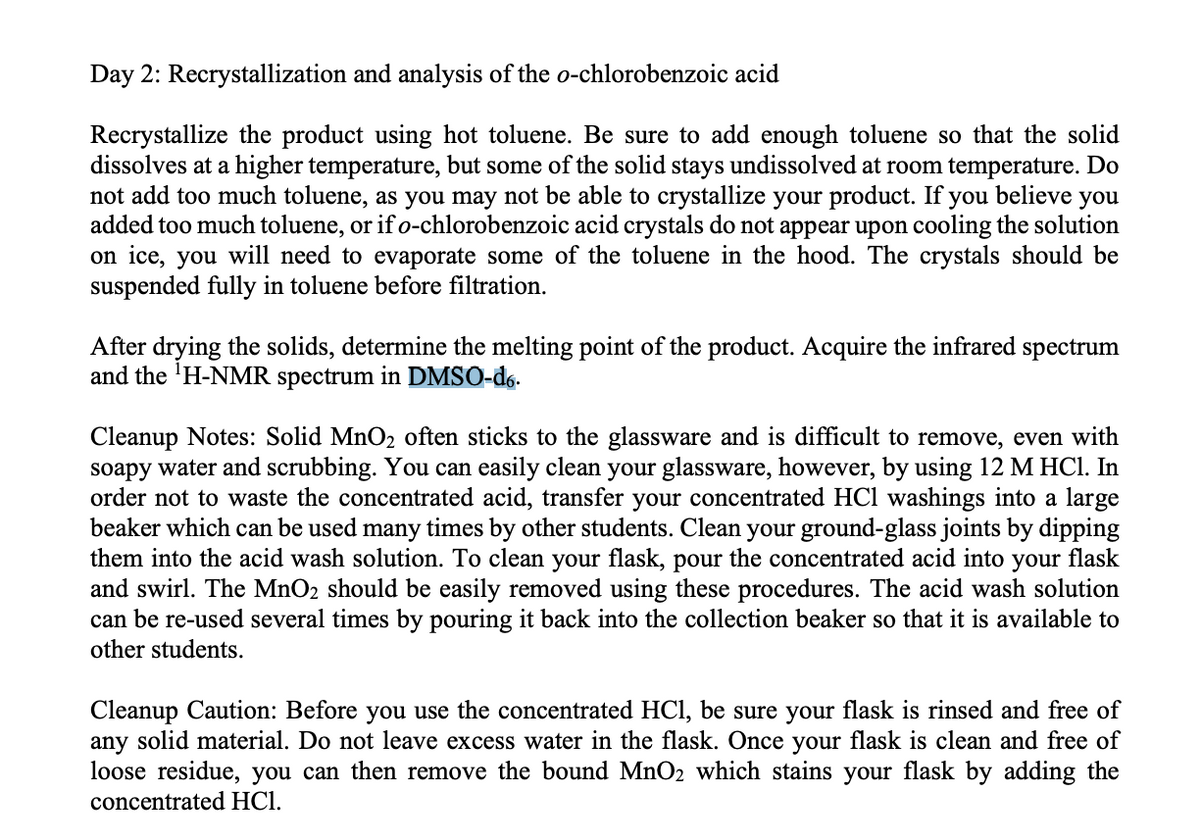Organic Chemistry: A Guided Inquiry
2nd Edition
ISBN:9780618974122
Author:Andrei Straumanis
Publisher:Andrei Straumanis
Chapter20: Acidity And Pka Of Phenols
Section: Chapter Questions
Problem 11E
Related questions
Question
Can I get this question answered with an explanation
Why is it better to acquire the 1H-NMR spectrum in DMSO-d6 and not in CDCl3?

Transcribed Image Text:Day 2: Recrystallization and analysis of the o-chlorobenzoic acid
Recrystallize the product using hot toluene. Be sure to add enough toluene so that the solid
dissolves at a higher temperature, but some of the solid stays undissolved at room temperature. Do
not add too much toluene, as you may not be able to crystallize your product. If
added too much toluene, or if o-chlorobenzoic acid crystals do not appear upon cooling the solution
on ice, you will need to evaporate some of the toluene in the hood. The crystals should be
suspended fully in toluene before filtration.
you believe
you
After drying the solids, determine the melting point of the product. Acquire the infrared spectrum
and the 'H-NMR spectrum in DMSO-d6.
Cleanup Notes: Solid MnO2 often sticks to the glassware and is difficult to remove, even with
soapy water and scrubbing. You can easily clean your glassware, however, by using 12 M HCl. In
order not to waste the concentrated acid, transfer your concentrated HCl washings into a large
beaker which can be used many times by other students. Clean your ground-glass joints by dipping
them into the acid wash solution. To clean your flask, pour the concentrated acid into your flask
and swirl. The MnO2 should be easily removed using these procedures. The acid wash solution
can be re-used several times by pouring it back into the collection beaker so that it is available to
other students.
Cleanup Caution: Before you use the concentrated HCI, be sure your flask is rinsed and free of
any solid material. Do not leave excess water in the flask. Once your flask is clean and free of
loose residue, you can then remove the bound MnO2 which stains your flask by adding the
concentrated HCl.
Expert Solution
This question has been solved!
Explore an expertly crafted, step-by-step solution for a thorough understanding of key concepts.
Step by step
Solved in 2 steps

Recommended textbooks for you

Organic Chemistry: A Guided Inquiry
Chemistry
ISBN:
9780618974122
Author:
Andrei Straumanis
Publisher:
Cengage Learning

Organic Chemistry: A Guided Inquiry
Chemistry
ISBN:
9780618974122
Author:
Andrei Straumanis
Publisher:
Cengage Learning